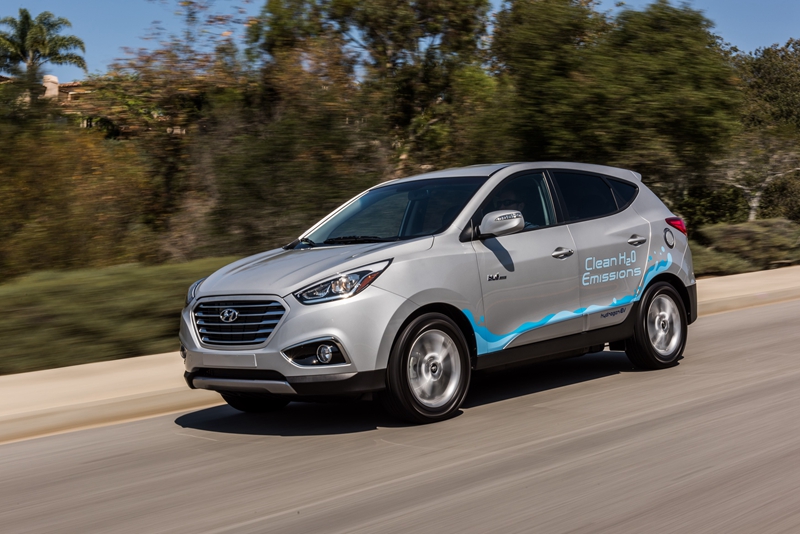 现代途胜燃料电池版的续航里程高达265英里,与常规途胜相同,燃料电池版途胜也是在现代汽车位于韩国蔚山的工厂中生产。
现代途胜燃料电池版的续航里程高达265英里,与常规途胜相同,燃料电池版途胜也是在现代汽车位于韩国蔚山的工厂中生产。 燃料电池车的加氢时间与同尺寸的汽油车很接近。图片为一辆正在加氢的现代途胜。
燃料电池车的加氢时间与同尺寸的汽油车很接近。图片为一辆正在加氢的现代途胜。 SunLine Transit Agency于2014年6月起在加州运营的第八代氢燃料电池大巴。
SunLine Transit Agency于2014年6月起在加州运营的第八代氢燃料电池大巴。 AC Transit于2010年9月起开始运营的第三代氢燃料电池大巴。
AC Transit于2010年9月起开始运营的第三代氢燃料电池大巴。 在密苏里州的堪萨斯城,一辆正在使用SAE Combo充电器充电的BMW i3。
在密苏里州的堪萨斯城,一辆正在使用SAE Combo充电器充电的BMW i3。 田纳西州西诺克斯维尔市,路边的一部双端口50千瓦直流快充充电桩。
田纳西州西诺克斯维尔市,路边的一部双端口50千瓦直流快充充电桩。
加州将计划建设更多的燃料电池车的加氢站,电动汽车充电站的则将会全美铺开以此来解决新能源汽车车主的加“油”的问题。美国加州燃料电池联盟(California Fuel Cell Partnership)执行总监 Bill Elrick,在底特律举办的2016先进汽车电池大会(2016 Advanced Automotive Battery Conference)xEV基建设施分会上提到。
Elrick直截了指出,“没有配套基础设施,你根本就卖不掉车。”
截至2015年底,加州只有两个出售氢燃料的加油站。Elrick承认,“我们没有足够的基础设施支持汽车厂商早期的新能源汽车推广。”
目前,加州加氢站的已经达到20个,数据位居全美之首。Elrick表示,“到2016年底,我们的氢燃料站预计将超过30个,这将极大地促进加州燃料电池汽车市场的发展。”
现阶段,加州市场共有两款在售的燃料电池乘用车,分别为丰田Mirai和现代途胜。此外,本田Clarity也将在今年晚些时候上市。据了解,Clarity将成为业内首款采用燃料电池、纯电动及插电式混合动力车通用平台所生产的燃料电池车。电动版和插电式混合动力版Clarity将在2017年亮相美国市场。
按照加州现有的加氢站分布,车主完全可以驾驶自己的燃料电池汽车,从洛杉矶开往旧金山。Elrick表示,“燃料电池车整个加氢过程与传统汽车加油时间差不多,仅需3到5分钟即可加满。”
加里福尼亚州的中期目标是建设100个氢燃料站。Elrick说道,“从一方面说,与分布在加州的13,000个加油站相比,这100个氢燃料站简直是微不足道。但是,只要我们合理安排这100个加氢站的位置,绝大多数加州市民都可以在6分钟内到达最近的那个。”
除了轻型乘用车外,加州还有4家公交公司拥有燃料电池大巴。
Elrick表示,“燃料电池大巴即将迎来全面商业化。这种大巴的成本开始逐渐下降至100万美元,甚至更低。我们预计,一旦政府的下一轮补助计划推出将大幅提高燃料电池大巴的销量,从而推动成本的进一步下降。”
预计,中载和重载燃料电池车可能会在今年晚些时候首次亮相。
Elrick表示,“目前,中载和重载燃料电池车仍处于早期阶段,大致情况与大约10年前的轻型车发展进度差不多。”
加州的氢气供应主要来源于空气分解及其他工业生产。Elrick表示,“但是,我们必须关注新的氢燃料生产工艺,特别是在可再生能源方面。”
电动车充电设施仍然不足
与此同时,加州非营利性组织电力科学研究院(Electric Power Research Institute)能源利用总监Mark Duvall表示,加州电动车充电基础设施的建设仍在进行之中。
“我认为我们已经解决了很多插电式电动车充电的问题,但距离目标还有一定差距。” Duvall还指出,需要在工作场所等公共区域建设更多的充电站。
目前,交流充电和直流快速充电已经走上了两条不同的道路。
Duvall在与《汽车工程》杂志的采访中表示,“我认为,无论你开多大的车,哪怕是大型SUV或皮卡,这些乘用车的充电需求也不大可能超过我们的交流充电标准,也就是(最高)19.2千瓦。”
目前,直流快充系统的充电功率在25到125千瓦之间,但其中绝大部分充电站都选择了50千瓦。
Duvall表示,“快充系统将不断发展,未来还将同时向后兼容当下大部分道路车辆。我认为,这种作法非常必要,毕竟目前全美还有成千上万辆采用现有直流充电设施的车辆。”
Duvall预测,随着雪佛兰(Chevrolet)Bolt和下一代日产聆风(Nissan Leaf)等一批长续航里程电动车的到来,未来电动车充电基础设施领域的投资将有所增长。
Duvall解释说,“当你开始对高功率充电设施有了更清晰的概念时,你就可以建设更多的直流快充设施,功率是现有设备的3到7倍。”
Duvall表示,由于市政、公用事业及各相关部门负责的部分各不相同,因此到底是谁在建设这些基础设施,以及这些设施到底属于谁都并不重要。Duvall表示,“关键在于建设!我觉得对于驾驶员而言他并不关心这些系统是谁家建造,因为在他眼里这些基础设施就是一个系统。而且我认为我们的工作还很不够,这才是最为关键的挑战之一。”
作者:Kami Buchholz
来源:SAE《汽车工程》杂志
翻译:SAE 中国办公室
More hydrogen fueling stations in California and additional electric vehicle charging stations across the U.S. could reduce the range anxiety consumers have about driving these-advanced technology vehicles, Bill Elrick, Executive Director of the California Fuel Cell Partnership told an xEV Infrastructure session audience at the 2016 Advanced Automotive Battery Conference in Detroit.
“You can’t sell a car if there isn’t infrastructure to support it,” Elrick flatly stated.
At the end of 2015, California had only two retail stations selling hydrogen fuel. “We didn’t have enough infrastructure out there to let the early automaker deployments prosper,” Elrick admitted.
Now, California has 20 hydrogen retail stations, the most of any state in the U.S., and “By the end of 2016, we expect more than 30 stations. That will put California in a prime place for the other fuel-cell vehicles (FVCs) that are coming to market,” Elrick said.
Fuel-cell passenger vehicles in the California market include the Toyota Mirai and the Hyundai Tucson Fuel Cell. The Honda Clarity Fuel Cell arrives late this year; Clarity will be the industry’s first vehicle to use the same platform underpinnings for fuel-cell, battery-electric and plug-in hybrid variants. Electric and plug-in hybrid versions of the Clarity are slated for U.S. launch in 2017.
With the present network of hydrogen retail stations in California, it’s possible to drive an FCV from Los Angeles to San Francisco. “And it will take the same amount of time as it does in a gasoline car because of the 3- to 5-minute fill time with hydrogen,” said Elrick.
California’s mid-range goal is 100 retail hydrogen stations. “On the one hand, 100 stations seems rather small compared to the 13,000 gas stations in the state. However, 100 well-placed stations throughout California will put the majority of the state’s citizens within six minutes of a hydrogen station,” he concluded.
Beyond light-duty passenger vehicles, four transit agencies in California operate fuel-cell buses.
“Fuel-cell buses are just on the verge of full commercialization. The costs are getting down to $1 million or less and we think the next round of government co-funding will be a push for mass purchases, bringing the costs down even more,” said Elrick.
The first appearance of fuel-cell medium- and heavy-duty vehicles is likely later this year. “It’s just in the early demonstration stage, so we’re about where we were with light-duty vehicles about a decade ago,” said Elrick.
California’s supply of hydrogen is coming from reforming gas and other industrial processes. “But we need to look at new hydrogen production—and what we should really be focusing on is renewable sources,” said Elrick.
EV charging: more still needed
Meanwhile, the charging infrastructure for electrified vehicles remains a work in progress, according to Mark Duvall, Director of Energy Utilization for the Electric Power Research Institute, a non-profit organization headquartered in California.
“I think we’ve solved a lot of the infrastructure problems with plug-in vehicles, but there are still some gaps,” said Duvall, noting a need for more workplace and public charging stations.
AC charging and DC fast-charging are on different trajectories.
“I find it very unlikely that passenger vehicles of any size—even when you start electrifying large SUVs and pickup trucks—would need more than what we have available through the AC standard, which is (a maximum of) 19.2 kilowatts,” Duvall said in an interview with Automotive Engineering.
The DC fast-charging infrastructure presently provides between 25 and 125 kilowatts, with most units providing 50 kW.
“Fast charging can evolve in such a way that it’s still backward-compatible with the vehicles that are on the road today. And I think that’s both necessary and possible because there are already hundreds of thousands of vehicles in the U.S. that use our existing DC charging infrastructure,” Duvall said.
As the Chevrolet Bolt, next-generation Nissan Leaf and other vehicles with a greater driving range become commonplace on roadways, Duvall expects to see more infrastructure investments.
“As you start to get a clearer vision of what this higher-power infrastructure looks like, you could just build the DC fast-charging infrastructure with its expected three to seven times power level increase alongside the existing equipment,” explained Duvall.
With municipalities, utility companies and others enabling different infrastructure pieces, Duvall said that it doesn’t matter who does the work or who owns it. “It’s about getting the work done. I think for drivers, it has to look like one system and I think we have quite a bit of work yet. I see that as a key challenge,” Duvall said.
Author: Kami Buchholz
Source: SAE Automotive Engineeringa Magazine
等级
打分
- 2分
- 4分
- 6分
- 8分
- 10分
平均分
